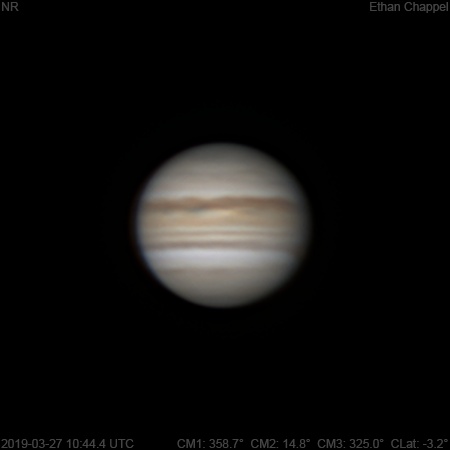
Jupiter UTC
CM1: 358.70°
CM2: 14.80°
CM3: 325.00°
CLat: -3.20°
Description
This is my second go at imaging from my university. This time, I felt confident enough to bring the C8, and I brought a Celestron Power Tank to power the Advanced VX and keep the laptop charging so it wouldn't prematurely lose power because of cold air. Unfortunately, I forgot to bring the 3x barlow to the field, but I don't think it would've brought in any extra resolution due to lackluster seeing. As with the previous imaging session, transparency was variable from high clouds.
Notes:
- The Equatorial Zone is still orange.
- The South Equatorial Belt is split by a white zone.
- The Great Red Spot is setting.
- There appears to be little to no wake trailing the GRS.
Equipment
ZWO ASI224MC
Celestron EdgeHD 8
Logs
FireCapture v2.6 Settings ------------------------------------ Observer=Ethan Chappel Camera=ZWO ASI224MC Filter=RGB Profile=Jupiter Diameter=39.23" Magnitude=-2.21 CMI=355.4° CMII=11.5° CMIII=321.8° (during mid of capture) FocalLength=1950mm (F/6) Resolution=0.39" Filename=2019-03-27-1040_0-EC-RGB-Jup.ser Date=2019_03_27 Start=10_38_45.278 Mid=10_40_00.285 End=10_41_15.292 Start(UT)=10_38_45.278 Mid(UT)=10_40_00.285 End(UT)=10_41_15.292 Duration=150.014s Date_format=yyyy_MM_dd Time_format=HH_mm_ss LT=UT -6h Frames captured=8243 File type=SER Binning=no Bit depth=8bit Debayer=yes DebayerAlgorithm=NearestNeighbor BayerPattern=RG ROI=284x292 ROI(Offset)=0x0 FPS (avg.)=54 Shutter=15.00ms Gain=280 (46%) USBTraffic=100 (off) WBlue=95 (off) SoftwareGain=10 (off) AutoGain=off AutoHisto=75 (off) Brightness=1 (off) HardwareBin=off FPS=100 (off) HighSpeed=off AutoExposure=off WRed=55 (off) Gamma=50 (off) Histogramm(min)=0 Histogramm(max)=124 Histogramm=48% Noise(avg.deviation)=0.19 AutoAlign=false PreFilter=none Limit=150 Seconds Sensor temperature=21.8°C FireCapture v2.6 Settings ------------------------------------ Observer=Ethan Chappel Camera=ZWO ASI224MC Filter=RGB Profile=Jupiter Diameter=39.23" Magnitude=-2.21 CMI=357.1° CMII=13.1° CMIII=323.4° (during mid of capture) FocalLength=2150mm (F/7) Resolution=0.36" Filename=2019-03-27-1042_7-EC-RGB-Jup.ser Date=2019_03_27 Start=10_41_27.668 Mid=10_42_42.676 End=10_43_57.685 Start(UT)=10_41_27.668 Mid(UT)=10_42_42.676 End(UT)=10_43_57.685 Duration=150.017s Date_format=yyyy_MM_dd Time_format=HH_mm_ss LT=UT -6h Frames captured=5998 File type=SER Binning=no Bit depth=8bit Debayer=yes DebayerAlgorithm=NearestNeighbor BayerPattern=RG ROI=284x292 ROI(Offset)=0x0 FPS (avg.)=39 Shutter=25.00ms Gain=350 (58%) USBTraffic=100 (off) WBlue=95 (off) SoftwareGain=10 (off) AutoGain=off AutoHisto=75 (off) Brightness=1 (off) HardwareBin=off FPS=100 (off) HighSpeed=off AutoExposure=off WRed=55 (off) Gamma=50 (off) Histogramm(min)=0 Histogramm(max)=118 Histogramm=46% Noise(avg.deviation)=0.60 AutoAlign=false PreFilter=none Limit=150 Seconds Sensor temperature=21.5°C FireCapture v2.6 Settings ------------------------------------ Observer=Ethan Chappel Camera=ZWO ASI224MC Filter=RGB Profile=Jupiter Diameter=39.23" Magnitude=-2.21 CMI=359.0° CMII=15.1° CMIII=325.4° (during mid of capture) FocalLength=2050mm (F/7) Resolution=0.37" Filename=2019-03-27-1045_8-EC-RGB-Jup.ser Date=2019_03_27 Start=10_44_38.142 Mid=10_45_53.146 End=10_47_08.150 Start(UT)=10_44_38.142 Mid(UT)=10_45_53.146 End(UT)=10_47_08.150 Duration=150.008s Date_format=yyyy_MM_dd Time_format=HH_mm_ss LT=UT -6h Frames captured=5998 File type=SER Binning=no Bit depth=8bit Debayer=yes DebayerAlgorithm=NearestNeighbor BayerPattern=RG ROI=284x292 ROI(Offset)=0x0 FPS (avg.)=39 Shutter=25.00ms Gain=350 (58%) USBTraffic=100 (off) WBlue=95 (off) SoftwareGain=10 (off) AutoGain=off AutoHisto=75 (off) Brightness=1 (off) HardwareBin=off FPS=100 (off) HighSpeed=off AutoExposure=off WRed=55 (off) Gamma=50 (off) Histogramm(min)=0 Histogramm(max)=152 Histogramm=59% Noise(avg.deviation)=0.64 AutoAlign=false PreFilter=none Limit=150 Seconds Sensor temperature=20.7°C FireCapture v2.6 Settings ------------------------------------ Observer=Ethan Chappel Camera=ZWO ASI224MC Filter=RGB Profile=Jupiter Diameter=39.23" Magnitude=-2.21 CMI=1.0° CMII=17.1° CMIII=327.3° (during mid of capture) FocalLength=2050mm (F/7) Resolution=0.38" Filename=2019-03-27-1049_1-EC-RGB-Jup.ser Date=2019_03_27 Start=10_47_55.537 Mid=10_49_10.540 End=10_50_25.543 Start(UT)=10_47_55.537 Mid(UT)=10_49_10.540 End(UT)=10_50_25.543 Duration=150.006s Date_format=yyyy_MM_dd Time_format=HH_mm_ss LT=UT -6h Frames captured=7497 File type=SER Binning=no Bit depth=8bit Debayer=yes DebayerAlgorithm=NearestNeighbor BayerPattern=RG ROI=284x292 ROI(Offset)=0x0 FPS (avg.)=49 Shutter=20.00ms Gain=250 (41%) USBTraffic=100 (off) WBlue=95 (off) SoftwareGain=10 (off) AutoGain=off AutoHisto=75 (off) Brightness=1 (off) HardwareBin=off FPS=100 (off) HighSpeed=off AutoExposure=off WRed=55 (off) Gamma=50 (off) Histogramm(min)=0 Histogramm(max)=161 Histogramm=63% Noise(avg.deviation)=0.13 AutoAlign=false PreFilter=none Limit=150 Seconds Sensor temperature=20.6°C